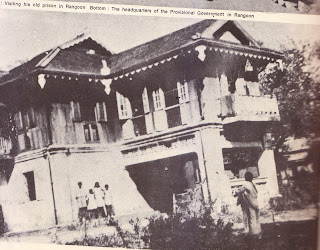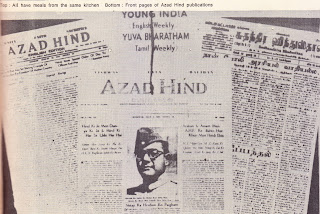
(courtsey Anuj Dhar, Face Book)
নেতাজি রাশিয়ায় - জানতেন গান্ধি, নেহরু, প্যাটেল সবাই : অনুজ ধর
নেতাজি কোথায়, কী ভাবে, কী দশায় মারা গেছেন, এই প্রশ্নই তাড়িয়ে বেড়াচ্ছে আজও দেশের মানুষকে। একেক সময় একেক তত্ত্ব সামনে এসেছে, যা নিয়ে কয়েকদিন ধরে আমরা একটি সিরিজ় প্রকাশ করছি। কিন্তু এরই মাঝে আরও একবার সাধারণ মানুষের দাবি প্রতিহত
On Nov 1, 1944, Netaji accompanied by his top aides , Kiani, Chatterjee, and Habibur Rahman Khan, flew to Tokyo for a series of discussions with Japanese leaders and also to participate in various other events arranged by his Japanese hosts. Returning to his hotel Netaji took a long time composing a letter addressed to the Soviet Ambassador The letter came back unopened within three days through the messenger who went with the letter. The Soviet Union entered the war against Japan violating the non-aggression pact for a possible gift of japan's northern islands to the Soviet Union.
 The Provisional Govt. of Free India got a loan of 100 million Yen (worth about $20 million) of which 90 million Yen remained unused when Japan surrendered to the Allies in August 1945. Netaji spent all the remaining funds as discgarge allowance to all members and employees of the INA and the Provisional Govt. Japan waived claims of its repayment.
The Provisional Govt. of Free India got a loan of 100 million Yen (worth about $20 million) of which 90 million Yen remained unused when Japan surrendered to the Allies in August 1945. Netaji spent all the remaining funds as discgarge allowance to all members and employees of the INA and the Provisional Govt. Japan waived claims of its repayment.On 23 rd January 1945, Netaji oberved his 48th Birth day in Rangoon and the people of Rangoon of Indian Origin donated gold and jewels weighing in total in one and half times his weight. Subhas Chandra Bose was a tall and big man weighing about 100 kilograms. Netaji rushed out to join the INA on the Irrawaddy front.
Two days later Netaji learned that Japan had radioed its readiness to surrender . In subsequent two days, he discharged civilian employees of his Government , disbanded some 23,000 troops of the INA based in and around Singapore and paid them off. On the eve of the Japanese surrender Netaji held a meeting of his cabinet ans issued a special message to his countrymen in East Asia and assured them to keep up spirits to enslave India in no time. Netaji with six top adjutants arrived by plane in Bangkok shortly after Japan officially surrendered to the Allies at noon on 15 August 1945. Netaji expressed his desire to join the Soviet forces in Manchuria to seek a way for continuing his campaign against Britain.
 The plane, with an estimated one metric ton of excess load , took off from Saigon at about 5 p.m. and flew north. About two hrs. later, the bomber touched down at Tourane, a Japanese base roughly midway between Saigon and Hanoi. The plane halted for the night and dismantled about 6oo kilos. By that time Netaji developed a friendship with Shidei
The plane, with an estimated one metric ton of excess load , took off from Saigon at about 5 p.m. and flew north. About two hrs. later, the bomber touched down at Tourane, a Japanese base roughly midway between Saigon and Hanoi. The plane halted for the night and dismantled about 6oo kilos. By that time Netaji developed a friendship with Shidei and talked in the room of the barrack which they shared. The plane left at 2 p.m. but involved in sn accident shortly after take off allegedly killing Netaji, General Shidei, two pilots and two other crews keeping Habibur Rahman , Nonogaki, Kono and five other persons with minor-to-serious injuries.
( A newspaper clip reporting the death of Lieutenant General Shidei and Subhas Chandra Bose)
This story of the death of Netaji is yet to be proved.
























 Moirang remained the ‘advance Headquarters of the INA’ for about three months and the Provisional Government of Azad Hind administered all the liberated areas of Manipur during this time. The people of Manipur from its hills and valleys extended all types of support and cooperation to the INA including food, donations and other materials. Even a couple of hundred Manipuris joined the INA movement.
Moirang remained the ‘advance Headquarters of the INA’ for about three months and the Provisional Government of Azad Hind administered all the liberated areas of Manipur during this time. The people of Manipur from its hills and valleys extended all types of support and cooperation to the INA including food, donations and other materials. Even a couple of hundred Manipuris joined the INA movement.




















































































